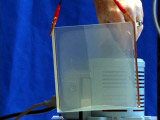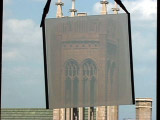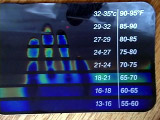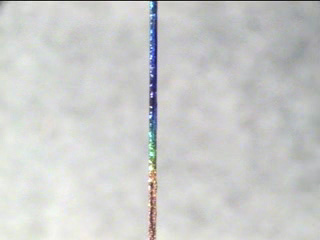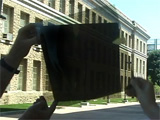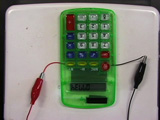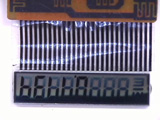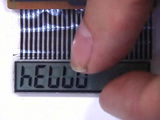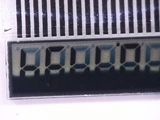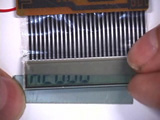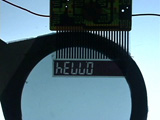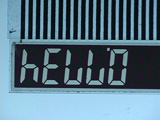
Liquid Crystals
Liquid crystals change opacity or color as a function of voltage or temperature.
This liquid crystal panel is transparent when a voltage is applied. Turning the switch off causes the panel to become opaque. The effect is reversible. The liquid crystal panel slowly becomes clear as the applied voltage is increased. One application of these panels is as a window blind or shade. By changing the applied voltage, the viewer can control the amount of transmitted light. It can also serve as a privacy screen. Some liquid crystals change color as the temperature changes and can be used as thermometers. A liquid crystal sheet placed over six square thermoelectric devices. As the temperature of each square changes the liquid crystal color changes. NiTi Transformation FrontWhen a NiTi wire is pulled, a phase transformation front moves through the wire. In this movie the wire has been painted with a liquid crystal to detect the temperature change that occurs during phase transformation. The wire is initially cold (black). As the transformation front moves from the top to the bottom of the image, the color changes to red at the front with a trailing rainbow of yellow-green-blue behind the front. The liquid crystal stays blue until the wire slowly cools. More NiTi movies. Crossed polarizers do not transmit light. A calculator liquid crystal display on a hotplate. A calculator liquid crystal display melted on a hotplate, then cooled back to the liquid crystalline state. A calculator liquid crystal display melted on a hotplate, then cooled back to the liquid crystalline state. A calculator liquid crystal display melted on a hotplate, then cooled back to the liquid crystalline state. When the polarizer is removed from behind a calculator liquid crystal display the numbers can no longer be observed. Rotating a polarizer under a calculator can invert the display colors of a liquid crystal display that is missing its normal polarizer. Rotating a polarizer under a calculator can invert the display colors of a liquid crystal display that is missing its normal polarizer.
Exploring the Nanoworld | MRSEC Nanostructured Interfaces
Copyright © 2013 The Board of Regents of the University of Wisconsin System.
This page created by George Lisensky, Beloit College. Last modified October 27, 2013 .
This page created by George Lisensky, Beloit College. Last modified October 27, 2013 .

